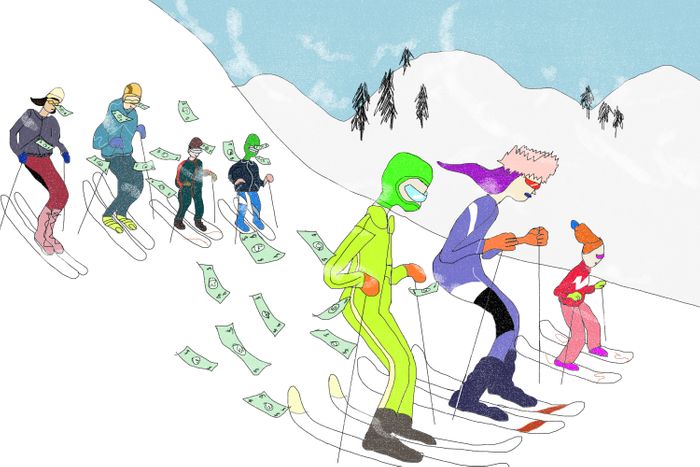
This article originally appeared in Brooding, a newsletter delivering deep thoughts on modern family life. Sign up here.
There are two kinds of people at a ski resort: Those who feel the wind of freedom and those who feel the record scratch of class anxiety. When I was young and skiing at my local mountain in Vermont, I felt free, in more sense than one. Everyone who made the high honor roll at my high school got a free season pass to Mount Snow, a genius incentive that got the Phish-head kids with wintertime-goggle tans to pay attention in Western Civ and also benefited try-hards like myself. Today, such incentives are rare, and a single day at the mountain costs my family around $400. My husband and I worked hard to teach our kids to ski, mostly so we could all have fun together, budget permitting, but also so that we wouldn’t feel downwardly mobile.
Then there’s my compulsion — embarrassing to admit, but here goes — to seek out some kind of kinship with the people working at these ski resorts, based on my having grown up skiing the humble local hills of Vermont. I am desperate for the people working at the mountains to consider me “one of them” rather than one of the jabroni horde from Connecticut. This urge to distinguish myself as “one of the people” is stupid and, most importantly, a fantasy that begins and ends with my own self-regard. I do wonder sometimes how far I’d be willing to go to communicate my “goodness.”
Recently, I had a chance to find out. It was the end of a day at Jay Peak and we decided to stop at the base-lodge pub for beers and hot chocolates before heading home. There’s something about being served at a table while wearing ski boots that makes me feel extra idiotic, and I became convinced, over the course of my family’s half-hour of sipping our beverages and spacing out, that our server, Jared, loathed us. There’s very little affordable housing in Vermont, I thought to myself as Jared took our order. This man deserves a better job. From across the bar, I thought I saw him gesture to one of his co-workers in such a way that clearly indicated we were a horrible table.
So imagine my surprise when, after he’d dropped the check, Jared returned with a pair of complimentary hot cocoas for my kids. When he took a seat and put his elbows up on the table, I thought to myself, We’ve arrived.
“Boys, there’s a concept called ‘play it forward,’” he explained solemnly to the kids. (Oh, the inner turmoil I endured, being a ski-town poseur who also happens to be a pedant, while I resisted correcting him — it’s pay it forward, Jared.)
“It’s up to people like us to make the world a better place,” he continued. “I give something to you, and instead of paying it back, you give something to someone else.” Wow, I said. Thank you so much. My sons mimicked my enthusiasm and thanked Jared even though they both know I don’t approve of back-to-back hot chocolates. After Jared left our table, the kids asked if they had to drink them — they were full, they said. Grinning maniacally, I told them to drink up. I wasn’t about to let Jared down. If the boys felt sick, well, that’s just the price they’d pay for making the world a better place.
This was not the first time my kids had heard of pay it forward. Last summer I blew a tire in the middle of nowhere and a local teenager stopped to help us. As he was leaving, I momishly called out, “You really helped us today!” Over his shoulder, he called back, “Now you have three days to do three good deeds, or else bad luck!” My kids and I stood in puzzlement as he drove away. Is this a fairy tale? I thought. Was that dude a witch? My kids took it very seriously, and we each kept assiduous track of our three good deeds, but since the goodness was in the eye of us beholders, they devolved into things like, “I didn’t steal my brother’s change when he left it on the table.” Not so much pay it forward as “resist the urge to be a jerk.”
“Pay it forward” as a concept has existed for centuries and entered the pop-culture lexicon thanks to a heartwarming 2000 film starring Helen Hunt and Kevin Spacey. Lately it’s been in the news because baristas working at Starbucks drive-thrus have gotten tired of enduring the viral practice of patrons paying it forward by paying for the car behind them; it snarls up the workflow in a low-paying job that is demanding enough as it is.
The pay-it-forward concept seems to resonate especially during this time of political and economic division. Making a small gesture of kindness at random might reassure us that goodness really does exist out there, even when the world — its chatbots, traffic jams, high rent, fascism, $10 lettuce, and all — feels unkind. Maybe Jared and I were both after the same thing, a sense that we’re all basically connected and basically good, even if he’s waiting tables and I’m wearing Patagonia ski pants that cost the same as a month of health insurance.
On the drive home from Jay Peak, while the kids groaned about their tummy aches (See?! I said triumphantly. There is such a thing as too much sugar!), I thought about what kind of gift-giving actually makes the world less harsh. The concept of paying it forward is appealing, but living in a consumer culture warps it. I was willing to force-feed my kids sweet sludge in order to affirm another person’s desire to be nice to me, but in truth, the double-hot-cocoa was grim.
What is the value of a gift that isn’t given freely? Gifts are meant to bind us together not by obligation but by gratitude. They’re supposed to remind us that we’re held by a group. Paying it forward imitates the ethos of a gift economy, where we’re bound together by the things we share. But in truth, pay it forward has a whiff of multilevel marketing about it. As a charitable practice, it’s very “Trump’s America.” You find a like-minded stranger on whom to bestow a treat of your choosing, and then profess to have faith that treats like this will flow back to you. What does this have to do with taking care of people?
How, in the midst of all this, can we teach kids the value of generosity in a meaningful way? Paying it forward has become a silly game — maybe Jared wasn’t mistaken when he called it “play it forward.” The encounters my kids have had with pay it forward have been bewildering and haven’t demonstrated the importance of giving what you can to anyone who needs help — which is the lesson I want them to learn. What about people who wouldn’t be able to continue to pay it forward when their turn comes — the unhoused, the unwell? Where’s their free Starbucks?
But its gamelike qualities are what make it easy for kids to embrace. People talk about the innate goodness of children, and I believe in that too, but family life is a harder place to model ethical behavior than we like to admit. Most every parent I know is engaged at some level in the struggle to secure a safe future for the kids, and that almost always comes at the expense of other kids’ chances. Every time a child nabs a spot in an elite school, another child … doesn’t. Robbing it backward, if you will.
Paying it forward is a nod to living in a gift economy, but ours is an exchange economy through and through. Pay it forward is fundamentally about quid pro quo, just turned outward; you probably wouldn’t pay forward a free coffee by covering a neighbor’s heating bill. In gift economies, the value of something isn’t determined by what it can be exchanged for, but rather by how meaningful it is to the recipient. This is something most of us can scarcely imagine, but kids’ imaginations are up to the task. To kids, a stick or a rock can be as precious as anything else.
In Lewis Hyde’s classic anthropological treatise The Gift from 1983, he famously refers to the ceremonial gifting of Kula rings among people who lived scattered across a vast island chain off Papua New Guinea. The rings were passed between trusted friends along with gossip and visiting, making their way through the islands and thereby keeping the communities in contact with each other. It was a marker of status to be given a ring, and so it became one to pass it on. Holding onto a ring for too long was frowned upon; their purpose was to be passed. I thought of the Kula rings recently when reading about a group of single moms who passed $50 back and forth between them through lean times. This is the kind of charity that can hold people together.
A lot of sharing child care works the same way. Exchanging sleepovers and dinners is how families come to rely on each other over time; it’s through the accrual of small favors back and forth that a sense of mutual reliance solidifies. Encouraging kids to borrow favorite books and toys from each other is another way to get the concept going.
Paying it forward was never meant to function as a “surprise!” to strangers. It was meant to create a ripple of good feeling that affirms the goodness of a group to itself. A ski resort isn’t a terrible metaphor for the earth: a rigorously exploited natural landscape populated by the wealthy and the serving class, and an ever-shrinking erstwhile middle. Where is there room for a truly kind gesture in a place as market structured as this? We do what we can, and I was breathlessly grateful to Jared for trying. On the drive home, we decided that the most valuable thing we can pay forward is our time and attention — the gift of being seen and remembered.
More From This Newsletter
- Parenting Through Our Control Issues
- When Kids Are Addicted to their Phones, Who Is to Blame?
- Why Are Parents On TikTok So Angry?





